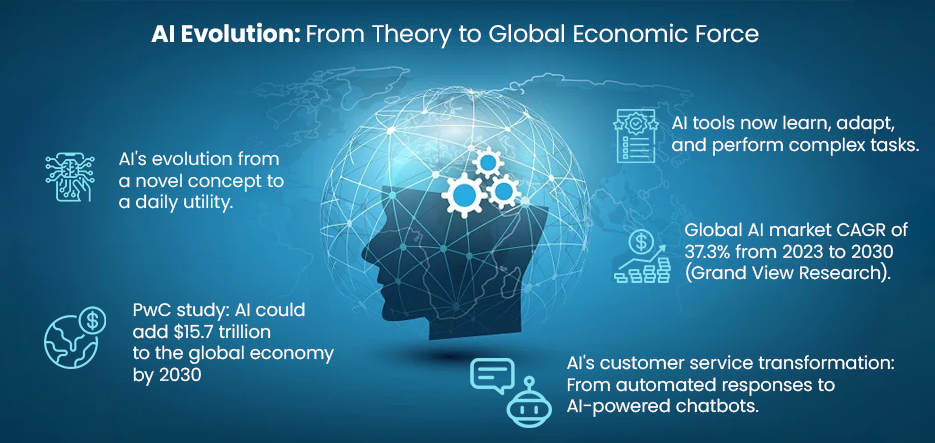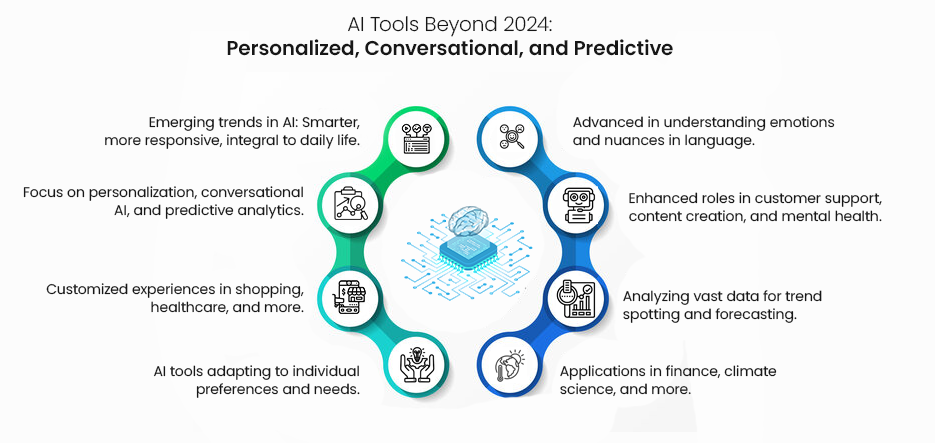Table of Contents
Artificial Intelligence (AI) has transformed the tech landscape, evolving rapidly from an intriguing idea to an essential part of our daily routines. AI’s journey, from its early days to its current prominence, is truly impressive. PwC’s research indicates that AI could add as much as $15.7 trillion to the global economy by 2030, primarily through boosting productivity and enhancing personalization. This highlights the significant role of AI tools in improving efficiency and generating value.
AI’s story began in the mid-20th century and centered on the ambition to build machines capable of intelligent actions. In the 1950s, AI was an emerging concept, mostly theoretical. But by the 21st century, AI has transitioned from mere theory to practical application. The past decade has witnessed a surge in AI capabilities, driven by progress in machine learning, natural language processing, and neural networks. These developments have empowered Artificial Intelligence tools to learn, adapt, and execute tasks previously only humans could handle.
A report by Grand View Research projects that the global AI market will grow at a compound annual growth rate (CAGR) of 37.3% from 2023 to 2030. This growth reflects AI’s expanding influence across various sectors. A notable example of AI’s evolution is its use in everyday activities. Look at how customer service has changed: from simple, automated responses to advanced, AI-driven chatbots that can tackle complex questions with a near-human level of understanding. This progression marks a technological leap and a shift in our interaction with machines.
Also Read: Grok: The New AI Chatbot by xAI
These statistics emphasize AI’s increasing importance and the enormous potential of these tools in shaping our future. AI tools are set to lead the charge in technological innovation in 2024, from boosting productivity to stimulating economic growth. Adopting these top AI tools will be crucial for maximizing the benefits of AI in the years ahead.

What are AI Tools?
AI tools are software systems that leverage artificial intelligence technologies to mimic human intelligence and perform tasks that typically require human cognition. These tools include a variety of capabilities, such as interpreting human language and identifying data patterns. They rely on cutting-edge technologies like machine learning, deep learning, natural language processing (NLP), and computer vision.
Designed for analyzing extensive datasets, these tools learn from the data and then make informed decisions or predictions based on that learning. Their applications range from straightforward functions like organizing emails to more intricate tasks like medical diagnosis.
How AI Tools are Transforming Industries
AI tools are revolutionizing multiple industries by enhancing efficiency, accuracy, and productivity. Here are some key transformations:
Healthcare
These tools in healthcare are improving patient outcomes and streamlining care processes. They assist in diagnosing diseases, personalizing treatment plans, and predicting patient risks. For instance, AI algorithms can analyze medical images to detect anomalies imperceptible to the human eye. According to Forbes, AI in healthcare is expected to reach $6.6 billion by 2021, indicating its growing impact in the sector.
Witness The Potential of AI in Healthcare!
Finance:
In the finance sector, these tools are used for fraud detection, risk management, and customer service. They analyze spending patterns to detect unusual transactions, helping to prevent fraud. AI chatbots provide 24/7 customer service, handling queries and transactions efficiently.
Retail:
Artificial intelligence is transforming the retail industry by personalizing customer experiences and optimizing supply chains. AI tools analyze customer data to provide personalized recommendations, enhancing customer engagement. They also forecast demand, manage inventory, and optimize logistics.
Manufacturing:
In manufacturing, these tools optimize production processes, reduce downtime, and enhance quality control. They predict equipment failures, allow for proactive maintenance, and monitor production lines to detect defects.
Transportation:
AI tools in transportation improve safety and efficiency. Autonomous vehicles use AI for navigation and decision-making. AI also optimizes routes for logistics, reducing delivery times and costs.
Entertainment:
In the entertainment industry, these tools are used for content recommendation, special effects, and audience analysis. Streaming services like Netflix use AI to recommend shows and movies based on user preferences.
Top 10 AI Tools for 2025
Text AI Tools: Revolutionizing Content Creation
In digital content creation, AI tools have emerged as game-changers. They’re not just simplifying the content creation process but redefining it. Among these, text tools stand out for their ability to assist in generating and enhancing written content. Let’s explore two of the best AI tools in this category: Copy.ai and Grammarly.
Copy.ai: The Writing Assistant
Copy.ai is a generative AI development company that has created a tool designed to assist in content creation. It uses advanced AI algorithms to generate creative and engaging text based on user inputs. Here’s how it stands out:
- Idea Generation: Copy.ai excels in brainstorming ideas. Whether you need blog topics, social media posts, or marketing copy, it provides numerous suggestions to kickstart your writing process.
- Content Creation: The tool turns your ideas into well-structured drafts. It’s particularly useful when facing writer’s block or tight deadlines.
- Customization: Copy.ai offers customization options, allowing you to tailor the content to your specific tone and style preferences.
- Time Efficiency: By automating the initial phases of writing, Copy.ai saves significant time, a crucial factor for businesses and individual creators alike.
Grammarly: Beyond Grammar Checking
Grammarly, best known for its grammar-checking expertise, has transformed into a versatile writing assistant. It goes beyond merely fixing errors; it aims to elevate the overall standard of your writing.
- Sophisticated Grammar and Style Checking: Grammarly goes beyond basic grammar checks. It offers advanced suggestions on sentence structure, word choice, and writing style, making your content more readable and engaging.
- Contextual Analysis: The tool analyzes the context of your writing to provide relevant suggestions. This feature ensures that your content is grammatically correct and contextually appropriate.
- Plagiarism Checker: An essential feature for content creators, Grammarly’s plagiarism checker scans your text against billions of web pages to ensure originality.
- Real-time Feedback: As you write, Grammarly provides real-time feedback, allowing you to immediately improve your text.
Image AI Tools: Crafting Visuals with AI
In the dynamic world of digital media, image AI tools have become a cornerstone for creators and businesses alike. These tools, developed by an innovative artificial intelligence development company, redefine the landscape of visual content creation. Let’s explore two prominent tools in this arena: Canva Pro and DALL·E 2.
Canva Pro: Design Simplified
Canva Pro, the enhanced version of the well-liked design platform Canva, is noted for its easy-to-use interface and powerful capabilities. This tool serves the needs of experts and beginners, democratizing the design process for all.
- Ease of Use: Canva Pro’s intuitive drag-and-drop interface makes it easy for users to create designs without experience. This simplicity is a game-changer in democratizing design.
- Rich Template Library: With thousands of customizable templates, Canva Pro offers a starting point for various projects, from social media graphics to business presentations.
- Advanced Editing Tools: Beyond basic editing, Canva Pro provides features like background remover, animation, and brand kit integration, enhancing the professional quality of designs.
- Collaboration Features: Canva Pro allows teams to collaborate on designs in real time, streamlining the design process in a collaborative environment.
DALL·E 2: The Future of Image Generation
DALL·E 2, developed by OpenAI, represents a significant leap in AI-driven image creation. This tool generates original, high-quality images from textual descriptions, showcasing the power of conversational AI solutions in visual creativity.
- Innovative Image Generation: DALL·E 2 interprets and visualizes textual descriptions with remarkable accuracy, creating unique and relevant images to the input.
- Creative Freedom: This tool opens up new avenues for creativity, allowing users to experiment with concepts and ideas that would be challenging or impossible to create manually.
- Time and Resource Efficiency: For businesses and creators, DALL·E 2 offers a way to generate visual content quickly and without the need for extensive resources, a significant advantage in fast-paced environments.
- Potential Applications: From advertising to art, DALL·E 2’s potential applications are vast, making it a valuable tool for various industries seeking innovative visual solutions.
In conclusion, image AI tools like Canva Pro and DALL·E 2 are at the forefront of a revolution in visual content creation. They embody the blend of simplicity, efficiency, and creativity essential in today’s digital landscape. As AI continues to evolve, these tools will undoubtedly play a pivotal role in shaping the future of design and visual communication.
Video AI Tools: Streamlining Video Production
The landscape of video production is transforming thanks to AI tools. These tools, developed by leading artificial intelligence solutions companies, make video production more accessible, efficient, and innovative. Let’s look at two such tools: Synthesia and Pictory AI.
Synthesia: Customizable Video Avatars
Synthesia, an artificial intelligence service, offers a unique approach to video creation. It allows users to create customizable video avatars, making production more flexible and creative.

- Avatar Customization: Users can create and customize avatars that speak in multiple languages, making Synthesia ideal for global content creation.
- Text-to-Video Technology: Synthesia converts written text into a video format, where the avatars speak the text. This feature simplifies the video creation, especially for users without technical video production skills.
- Wide Application: From educational content to marketing videos, Synthesia caters to a broad range of applications, demonstrating the versatility of AI in video production.
- Time and Cost Efficiency: Synthesia reduces the time and cost associated with traditional video production, making it a valuable tool for businesses and content creators.
Pictory AI: Automated Video Editing
Pictory AI, another innovative product from an artificial intelligence solutions company, focuses on automating the video editing process. It simplifies video production, making it more accessible to non-professionals.
- AI-Powered Editing: Pictory AI uses AI to automate the editing process. It can trim, cut, and edit videos based on user inputs, significantly reducing the manual effort involved in editing.
- Text-to-Video Conversion: Similar to Synthesia, Pictory AI can convert text into video, but it also adds the capability to include images and clips, creating a more dynamic video experience.
- Customization Options: Although automated, Pictory AI offers various customization options, allowing users to tailor their videos to specific needs and styles.
- Efficiency for Content Creators: For bloggers, marketers, and educators, Pictory AI offers a quick way to transform written content into engaging video formats, enhancing their content strategy.
SEO AI Tools: Optimizing for the Web
In the digital age, where web presence is crucial for success, SEO AI tools have become indispensable. Developed by machine learning solutions companies, these tools leverage AI and machine learning services to optimize websites for better visibility and ranking. Let’s examine two such tools: Surfer and Ahrefs.
Surfer: Data-Driven SEO Insights
Surfer stands out as a data-driven tool that provides deep insights into SEO strategies. It’s designed to help websites improve their visibility and ranking on search engines.
- Content Optimization: Surfer analyzes your website’s content and compares it with top-ranking pages, offering recommendations to optimize for relevant keywords.
- SEO Audit: It conducts thorough SEO audits, identifying issues hindering your website’s performance and providing actionable solutions.
- User-Friendly Interface: Surfer’s interface is designed for ease of use, making complex SEO data understandable and actionable for users with varying levels of SEO expertise.
- Real-Time Data: Using real-time data, Surfer offers up-to-date insights, ensuring your SEO strategy aligns with the latest search engine algorithms.
Ahrefs: Comprehensive SEO Tool
Ahrefs is renowned for its comprehensive approach to SEO. It’s a tool that covers all aspects of SEO, from keyword research to site auditing.
- Extensive Keyword Research: Ahrefs provides an extensive database of keywords, helping users uncover the keywords their target audience is searching for.
- Site Auditing: It offers detailed site audits, highlighting technical and on-page SEO issues that must be addressed to improve site performance.
- Backlink Analysis: Ahrefs is particularly known for its backlink analysis capabilities, allowing users to track and analyze the backlink profile of their own and competitors’ websites.
- Competitor Analysis: It also enables users to conduct thorough competitor analysis, gaining insights into competitors’ SEO strategies to inform their own.
In conclusion, SEO AI tools like Surfer and Ahrefs transform how businesses optimize their websites for search engines. By leveraging AI and machine learning, these tools provide insights and recommendations that are both data-driven and actionable, making them essential for anyone looking to enhance their web presence and performance.
Voice AI Tools: Transforming Audio Interactions
Voice AI tools are revolutionizing how we interact with technology, making audio interactions more intuitive and efficient. Developed by companies specializing in AI and ML, these tools are not just convenient; they’re changing the dynamics of task management and audio editing. Let’s explore Jasper and Descript, two leading tools in this field.
Jasper: Voice Command Efficiency
Jasper, a tool designed for voice command efficiency, is making strides in simplifying voice-based task management. It’s a boon for those looking to hire AI developers to create seamless voice interaction systems.
- Intuitive Voice Commands: Jasper allows users to perform tasks using simple voice commands. This feature is particularly useful in hands-free scenarios or when multitasking.
- Integration with Various Platforms: It integrates with various platforms, enhancing its utility across applications, from smart homes to business tools.
- Customization: Jasper offers customization options, enabling users to tailor the voice command system to their needs and preferences.
- Accessibility: By simplifying voice commands, Jasper makes technology more accessible, especially for individuals with physical or visual impairments.
Descript: Advanced Audio Editing
Descript is a tool that stands out for its advanced audio editing capabilities, including transcription features. It’s a go-to tool for those looking to hire AI ML consultants for cutting-edge audio processing.
- Automated Transcription: Descript offers fast and accurate automated transcription, converting audio files into text, which is a significant time-saver for podcasters, journalists, and content creators.
- Editing via Text: One of Descript’s unique features is the ability to edit audio by editing the transcribed text. This approach simplifies the editing process, making it more accessible and efficient.
- Overdub Feature: Descript’s Overdub feature allows users to create realistic voiceovers using AI, which is useful for correcting mistakes or creating new content without additional recording.
- Collaboration Tools: It also offers collaboration tools, enabling teams to work together on audio projects and streamlining the production process.
In conclusion, voice AI tools like Jasper and Descript are at the forefront of transforming audio interactions. They offer innovative features that enhance efficiency and open up new possibilities in how we manage tasks and edit audio. As AI continues to evolve, these tools are set to become even more integral in various fields, from content creation to smart technology.
Predictions and Trends in AI Development

Looking past 2024, the world of AI tools is ready for a big jump forward. We’re seeing small changes and a real shift in how these tools work. The tools just starting to show their power will soon be even smarter, more responsive, and a bigger part of our everyday lives.
A major trend is these tools are getting personal. They’re learning to get what we like and do, giving us ideas and help that fit just right. This custom touch will spread to all areas, from online shopping to health care, making these tools a key part of our day.
We’re also going to see AI that can chat more like us. These tools will improve at picking up on how we feel and the hidden meanings in our words. This means they’ll be more helpful in roles like customer support, making content, and even looking after our mental well-being.
Another big move is AI getting smarter with predictions. They’ll be great at looking through big piles of data to spot trends and guess what’s coming. This skill will be super important in money matters, like guessing where the market’s headed, and in science, like tracking how our world’s climate changes.
Potential Future Applications of AI Tools
The possibilities seem endless when we think about what AI tools might do next.
In health care
AI could be a game-changer here. We could see AI spotting health issues early or crafting care plans based on our DNA. These tools could help us stay well and get better faster.
In schools
AI could give each student a learning experience that’s just for them. It could change with their learning speed and what they’re into, making school more fun and fair. This could help all students reach for the stars. At the same time, many AI-based services are being developed, the so-called AI writers, which can make life easier for students in routine tasks.
Businesses
Businesses are in for a change, too. AI could take on tricky tasks, monitor market trends, and offer tips to make smart moves. They could be a big help in keeping supply chains smooth, making operations better, and giving customers what they want.
Environment
AI could also be a hero for our planet. It could watch over our natural treasures, warn us about environmental dangers, and find ways to live without hurting the earth. This could be key in fighting big problems like climate change and protecting all kinds of life.
Daily Lives
And in our daily lives, AI could become a part of our homes and cities. Our homes could know what we need and like. Our cities could use AI to keep traffic moving, save power, and improve public services.
Also, read About AI and Sustainability
Conclusion
Reflecting on 2024’s AI tools, we see they’ve streamlined tasks and sparked new potential across sectors. Text tools like Copy.ai and Grammarly have improved our writing. Image tools like Canva Pro and DALL·E 2 have redefined visual creativity. Video tools such as Synthesia and Pictory AI have made video production easier. SEO tools like Surfer and Ahrefs have reshaped web optimization. Voice tools, including Jasper and Descript, have upgraded audio interactions, making them more natural and effective.
These innovations come from top artificial intelligence companies in the USA and worldwide. They’ve simplified tasks and fostered new ways to be creative and efficient.
The road ahead for AI tools is full of promise. As AI and machine learning grow, we’ll see more sophisticated tools. AI will blend into various sectors smoothly, making experiences smarter and more intuitive.
- Increased Personalization: These tools will adapt to users, offering tailored experiences and learning from their interactions.
- Greater Accessibility: These tools will become easier, welcoming more people to try them.
- Enhanced Efficiency: AI advancements will aim to cut down the time and energy needed for tasks.
- Ethical AI Development: The rise of AI stresses the ethical creation of AI. This ensures that the tools benefit and are used correctly.
Take the First Step Towards Excellence With A3Logics
FAQs
What are AI Tools, and How Do They Work?
AI tools are applications or platforms that harness artificial intelligence. They carry out tasks that usually need human smarts. These include learning, solving problems, recognizing patterns, and understanding language. AI tools process and learn from vast data. They then use what they’ve learned to perform tasks by applying machine learning, natural language processing, and neural networks.
How Can AI Tools Boost Business Productivity?
AI tools boost productivity by taking over routine tasks. They analyze data for insights and aid in making better decisions. They tackle repetitive tasks tirelessly. This lets human workers do more complex, creative work. AI tools also quickly shift through data to spot trends. These insights can shape business strategies and ramp up operational efficiency.
How Do AI Tools Aid SEO Strategies?
AI tools aid SEO by offering insights based on data, easing keyword research, and fine-tuning content for search engines. Tools like Surfer and Ahrefs assess website data, recommend keywords, and guide on improving website rankings. They decode search engine algorithms. This lets businesses tailor their content and strategies for better search result rankings.
What Role Do AI Tools Have in Video and Image Editing?
AI tools automate editing tasks in video and image editing. They improve visual quality and enable realistic graphics and animations. For example, Synthesia for video and Canva Pro for images make editing simple. They provide advanced features and let users create top-quality visuals easily.
Can AI Tools Enhance Customer Service?
AI tools can boost customer service efficiency. AI-driven chatbots and assistants handle many customer questions at once. They give instant replies and cut down wait times. The AI tools learn from interactions to provide more tailored service. Also, they can pass complex issues to human agents, ensuring efficient and high-quality support.
How is AI Tools Revolutionizing Project Management?
AI tools revolutionize project management by automating routine work, giving predictive insights, and boosting team collaboration. They assist in allocating resources, assessing risks, and planning projects. They do this by evaluating past data and current trends. Also, AI tools improve team communication and collaboration, leading to more efficient project management.




